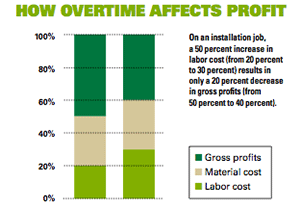 You’ve told your guys a thousand times, “No overtime!” It’s an unnecessary premium cost that cuts deep into your margins. Or is it?
You’ve told your guys a thousand times, “No overtime!” It’s an unnecessary premium cost that cuts deep into your margins. Or is it?
The unplanned, capricious use of overtime hurts financial performance. We rarely bid work at overtime rates, so it hurts margins. There are, however, times when the strategic use of overtime makes sense, as long as it’s limited and part of a strategy. These occasions include dealing with labor spikes, handling overbudget sales and service-recovery situations.
Coping with labor spikes
In some markets, landscape maintenance operations spike at certain times of the year for a brief time. The only way out of working overtime is hiring extra bodies for a few weeks, then letting them go or moving them to another area of the business. The challenges include:
› Finding a number of workers in a hurry is always difficult.
› Finding good workers who are willing to accept a job that only promises employment for a few weeks might not be realistic.
› Training temporary labor puts a strain on your most valuable people.
Additionally, the risks are great:
› Untrained workers on your sites puts quality and safety at risk.
› The layoffs must be timed right. If the work isn’t well understood, there’s a risk the extra workers will be kept on too long, which is a costly mistake.
When dealing with labor spikes, keys to using a successful overtime strategy are:
› Understanding the man-hour needs exactly. Strategic overtime doesn’t mean working an indefinite number of hours. It’s limited to the job budgets.
› Planning a duel strategy—temporary labor plus overtime, depending on the hours. Determine the hour limit you’re willing to work people. Calculate the hours exceeding this limit, and hire temporary help to cover the difference.
› Budgeting for the overtime. Strategic overtime in this scenario can be put in your financial budget in advance so the labor premium is planned, not a financial hit.
Before deciding on strategic overtime, look closely at the schedule of operations. There may be more leverage in flexing the schedule. For example, in the Southeast, mulch operations can be done during the winter when landscapes are dormant. That’s not the case in the Northeast where snow cover and frozen ground pushes a mulch schedule on top of spring cleanup and mowing operations.
Selling overbudget
You should have staff, vehicles and equipment to handle your planned sales volume. Hopefully, you beat your sales targets from time to time. But what do you do if it’s half a crew? Maybe your crews typically produce $20,000 a month each and you sell an additional $10,000? It might not make sense to buy an additional vehicle plus equipment and hire more people for half a route, especially if it’s late in the season (you’ll make payments all winter, with the rig sitting idle). It might make sense to work overtime strategically to cover the extra volume until additional sales are generated and a new full route can be created. This tactic is unbudgeted, but as long as you’re running ahead on revenue, it won’t ruin your financials.
Overtime hours aren’t unlimited here; hour budgets must still be met.
What about overselling the budget on installation? If your clients will tolerate stretching the schedule, you might be able to finish the work without overtime, but it’s usually not the case. When installation is oversold, it makes sense to work strategic overtime.
In the first place, installation profits come from markups on labor and materials. The materials’ profits are unaffected by overtime (you’re making the material markup whether your workers are on overtime or not). Labor often is a smaller portion of the direct cost in installation work, often less than 25 percent. A premium on this portion has a smaller effect on the overall gross profit than in labor-only services like maintenance. (See chart below.)
Besides that, overselling your installation budgets generally doesn’t mean an increase in overhead, so even though there’s margin erosion in the overtime, you usually can expect to keep your profits. More gross profit dollars contributing to cover the same overhead will help your business, even if the gross margins are smaller.
There’s a point where you simply need to add more staff if installation sales can be sustained at higher-than-budget targets. However, as the last market downturn showed, limit your investment in installation overheads so you can pull back as painlessly as possible.
Service failure
From time to time, we let clients down. Whether we fall behind, make mistakes or miss something, it’s impossible to never disappoint anyone. Working overtime is an expensive way to fix problems, but this is a relationship business. People overwhelmingly buy landscape based on relationships. Better to lose money in the short term than lose the relationship in the long term. Overtime isn’t the path to financial success, but if limited and used strategically, it can be part of the arsenal in coping with labor spikes, windfall sales or service challenges.

